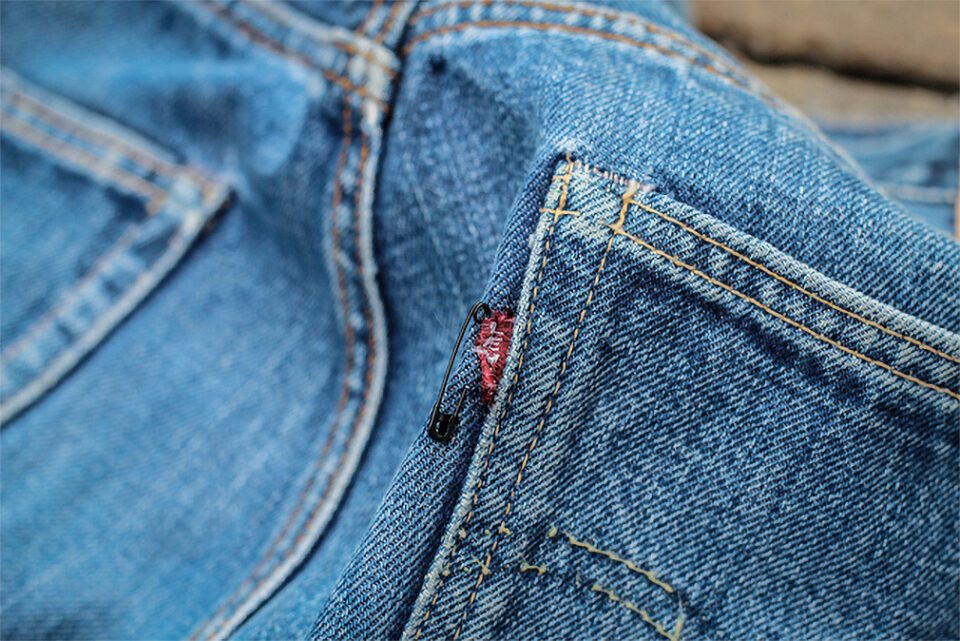Dating Levi’s 501s, the “Big E tab” is only part of the story
Determining the production date of vintage Levi’s 501 jeans can be an exciting and rewarding treasure-hunt, as it allows you to trace the history of these fabulous jeans. Here’s a step-by-step guide to help you identify the era of your vintage Levi’s 501 jeans.
Check the Red Tab
This is the classic route to determining whether you have stumbled across a fortune in the second-hand store or merely have a pair of cheap but perfectly serviceable strides. The red tab on the back pocket is a crucial indicator of the jeans’ production period, and the evolution of this well-documented branding device will give you a pretty good idea as to how old your 501s are from the get-go.
1: Big E Red Tab (Pre-1955):
If the red tab features a stylized capital “E” facing out, your jeans are likely from before 1955. This style is considered the most valuable and sought-after among vintage Levi’s enthusiasts and Denimhead collectors.
2: Small e Red Tab (1955-1971):
From 1955 to 1971, Levi’s switched to a smaller stylized “e” on the red tab, with the lettering facing the wearer’s right side when the jeans are worn.
3: No Red Tab (1971-Present):
Since 1971, Levi’s has produced Levi’s 501 jeans without the red tab altogether. Apart from some modern interpretations, that is, but the denim itself is more than a clear give-way that this is not a vintage pair of Levi’s that you are holding. (Sorry…)
The Care Tag
It is often overlooked as another key determinant of age, but it is worth taking a few moments to examine the care tag. The care tag is typically located on the inside seam of the waistband, and it provides additional clues about the vintage of your 501s.
It is worth noting, too, that whilst fake Levi’s 501s are relatively and mercifully rare out in the wild, they do turn up from time-to-time and the forger often forgets to pay attention to the care tag.
4: No Care Tag (Pre-1973):
If there’s no care tag present, your jeans are likely from before 1973, as Levi’s started adding care tags around that time.
5: Care Tag Style:
The style and information on the care tag can also help narrow down the production date. For instance, earlier care tags may have a simpler format with fewer details compared to later versions.
Inspect the Stitching
The stitching style and details can also offer clues about the jeans’ era. Overall, it is harder to fake than either the red tab or the care tag. So, if your forensic skills yield a match with these quite simple checks, you’re probably on to a winner.
6: Arcuate Stitching:
The arcuate stitching on the back pockets is a hallmark of Levi’s jeans. If the stitching is closer to the edge of the pocket, it indicates an earlier production date.
7: Belt Loop Stitching:
The stitching on the belt loops can also provide some insights. For example, earlier jeans may have bar tacks on the belt loops, while later versions may have a simpler stitching pattern.
8: Check the Back Cinch:
The back cinch, a small strap of fabric at the back of the waistband, was a feature of Levi’s jeans until 1937. If your jeans have a back cinch, they are likely from before 1937. Jackpot!
Consult Our Other Articles
We have written about this before, hoping that these resources provide detailed information, images, and discussions to help you identify and date your vintage Levi’s 501 jeans.
How To Determine Production Date of Vintage Levi’s 501 Jeans
How To Determine Production Date Of Vintage Levi’s Denim Jackets
Remember that dating vintage Levi’s 501 jeans is not an exact science, and some details may overlap between different eras. However, by carefully examining the these tell-tale features, you can gain a good understanding of the approximate production period of your vintage Levi’s 501 jeans.
Good luck!


